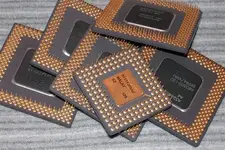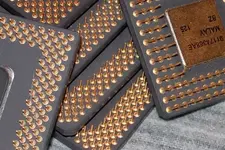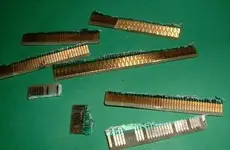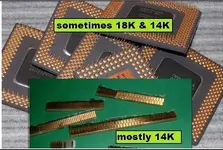You are using an out of date browser. It may not display this or other websites correctly.
You should upgrade or use an alternative browser.
You should upgrade or use an alternative browser.
Gold ?????
- Thread starter mojjax
- Start date
Woodland Detectors
Gold Member
- Joined
- Nov 23, 2008
- Messages
- 12,712
- Reaction score
- 142
- Golden Thread
- 0
- Location
- Toll Free ~ 855~966~3563
- 🏆 Honorable Mentions:
- 1
- Primary Interest:
- Relic Hunting
dozer dan
Hero Member
goldguru said:pretty much what U see is what U get for content they only plated as well..prob not enough to fill a small cavity..lol.
the pins are not solid..
& total there prob less than a cple bucks.
Ebay'm
or destroy them. you never know what kind of personal info can be extracted from
passed along used p.c. chips.
Blacksheep
Bronze Member
Check ebay using "scrap cpu" as a search, you may be surprised. 

Gunny71
Sr. Member
- Joined
- Jan 14, 2009
- Messages
- 311
- Reaction score
- 36
- Golden Thread
- 0
- Location
- Texas by Gawd
- Detector(s) used
- Minelab E-TRAC
- Primary Interest:
- All Treasure Hunting
or destroy them. you never know what kind of personal info can be extracted from
Just FYI- Hard drives are the only thing in a PC that information is stored on. Used processors, memory modules, etc are totally safe to toss.
- Joined
- Nov 19, 2006
- Messages
- 15,108
- Reaction score
- 13,058
- Golden Thread
- 0
- Location
- Where good deeds are performed daily
- Detector(s) used
- Garrett Fortune Hunter, White's CoinMaster, Garrett American S3, Compass Coin Magnum and a couple of others you will only find in museums!
- Primary Interest:
- All Treasure Hunting
Kind of along with the idea of this thread...I've heard that catalytic converters have platinum in them. What's this all about?
Scott
Scott
traderoftreasures
Bronze Member
- Joined
- May 9, 2009
- Messages
- 2,211
- Reaction score
- 7
- Golden Thread
- 0
- Location
- central, Illinois
- Detector(s) used
- white's spectrum VX3
i have been a catalytic buyer for years thats all i do. i have a web site with prices. http://www.firstamericancore.com the converters also have pladium, and rhodium. if any one has many, i can pick them up or they can be mailed to me. i pay GREAT ! maybe near the best in the world.AU24K said:Kind of along with the idea of this thread...I've heard that catalytic converters have platinum in them. What's this all about?
Scott
Attachments
traderoftreasures
Bronze Member
- Joined
- May 9, 2009
- Messages
- 2,211
- Reaction score
- 7
- Golden Thread
- 0
- Location
- central, Illinois
- Detector(s) used
- white's spectrum VX3
i think intel chips can go for up to 25 bucks each... mother boards are 2.65 right now per pound. my brother melted down probably 100 computers with acid and only got about 5 grams of pure gold, but they were old crappy apple computers.mojjax said:My friend was going to throw these in the trash . I said "I'll takem"
Are they worth saving ?
They are INTEL Chips .
dozer dan
Hero Member
"
Are they worth saving ?
They are INTEL Chips .
[/quote]i think intel chips can go for up to 25 bucks each... mother boards are 2.65 right now per pound. my brother melted down probably 100 computers with acid and only got about 5 grams of pure gold, but they were old crappy apple computers.
[/quote]
would that be crapple?
Are they worth saving ?
They are INTEL Chips .
[/quote]i think intel chips can go for up to 25 bucks each... mother boards are 2.65 right now per pound. my brother melted down probably 100 computers with acid and only got about 5 grams of pure gold, but they were old crappy apple computers.
[/quote]
would that be crapple?
cyberdan
Silver Member
- Joined
- Dec 12, 2006
- Messages
- 4,596
- Reaction score
- 2,222
- Golden Thread
- 0
- Location
- Very Northern Left Coast
- Detector(s) used
- XLT & Bigfoot
- Primary Interest:
- All Treasure Hunting
Went to your web site. are your prices for the entire converter or just the insides? Never heard of all those names, are they all converters? Those things must be pretty heavy. Since I am in SoCA does it really pay to ship them back east to you?traderoftreasures said:i have been a catalytic buyer for years thats all i do. i have a web site with prices. http://www.firstamericancore.com the converters also have pladium, and rhodium. if any one has many, i can pick them up or they can be mailed to me. i pay GREAT ! maybe near the best in the world.
traderoftreasures
Bronze Member
- Joined
- May 9, 2009
- Messages
- 2,211
- Reaction score
- 7
- Golden Thread
- 0
- Location
- central, Illinois
- Detector(s) used
- white's spectrum VX3
yes the prices are for different converters. and the price is for full converters / half full are only half price. If you can buy for cheap or get them for free it's worth it also you can ship many of them cheaper and you can get insurance which will assure that you get paid now matter the circumstance. the 4 dot, vent tube, single plug, jumbo, and gm are all general motor converters, the strait edge, fish tail, and jeep are all Chrysler,plymouth,dodge converters. smalls, Pres, 2 pipe, 3 pipe scorpions, and wide gap rear ford are all fords. and most of the rest are imports. some are rhodium rich, some are palladium rich. in a good mixed pile it would probably bring around 40 to 45 dollars eachcyberdan said:Went to your web site. are your prices for the entire converter or just the insides? Never heard of all those names, are they all converters? Those things must be pretty heavy. Since I am in SoCA does it really pay to ship them back east to you?traderoftreasures said:i have been a catalytic buyer for years that's all i do. i have a web site with prices. http://www.firstamericancore.com the converters also have palladium, and rhodium. if any one has many, i can pick them up or they can be mailed to me. i pay GREAT ! maybe near the best in the world.
cw0909
Silver Member
Blacksheep
Bronze Member
Interesting, wish I had kept some of those older components I tossed a few years back! 
http://cgi.ebay.com/SCRAP-GOLD-COMP...ViewItem&pt=Coins_Bullion&hash=item20b0967ea3
http://cgi.ebay.com/Scrap-Gold-Reco...ViewItem&pt=Coins_Bullion&hash=item2306b6e277

http://cgi.ebay.com/SCRAP-GOLD-COMP...ViewItem&pt=Coins_Bullion&hash=item20b0967ea3
http://cgi.ebay.com/Scrap-Gold-Reco...ViewItem&pt=Coins_Bullion&hash=item2306b6e277
As an eBay Associate we earn from qualifying purchases.
goldsilverpro
Jr. Member
cw0909 ,
None of the gold plating on most any electronic component is 10K, 14K, or 18K. The only exception I've seen is a Au/Pd alloy that was used for plating reed switches. I'm sure there are other rare exceptions, but these certainly don't include the parts in the photos. The plating on the ICs in the photo is most probably 99.99% pure (24K). Anything less would discolor when they are heated during the chip attachment or lid attachment (for the one with the gold plated lid, at least). Gold plated PCB fingers are nearly always plated with gold of at least 99% (23.76K) purity. For fingers, connector pins, or anything that could exhibit wear from multiple insertions, from .1% to 1% of cobalt or nickel is normally added to produce a harder deposit.
There are gold plating baths, used for decorative purposes, such as costume jewelry, that are called 14K, 18K, etc. However, the deposits from these only give a 14K or 18K color. In actuality, they are about 21 -23K. The color of plated gold is different than that of cast gold. With plated gold, it takes much less alloying ingredients to produce a pale color. Even with the addition of only 1% cobalt (99% gold), the plating will be noticeably paler than 24K plating, under the right light.
I'm curious where you got the idea that these parts are plated with 10, 14, or 18K gold. If an electronic tester was used to get this information, I'm afraid they are worthless for the determination of the purity of gold plating, unless it is very, very thick. The thickest gold plating you're likely to find on any electronic parts is about .0001", and I doubt if even that would qualify.
None of the gold plating on most any electronic component is 10K, 14K, or 18K. The only exception I've seen is a Au/Pd alloy that was used for plating reed switches. I'm sure there are other rare exceptions, but these certainly don't include the parts in the photos. The plating on the ICs in the photo is most probably 99.99% pure (24K). Anything less would discolor when they are heated during the chip attachment or lid attachment (for the one with the gold plated lid, at least). Gold plated PCB fingers are nearly always plated with gold of at least 99% (23.76K) purity. For fingers, connector pins, or anything that could exhibit wear from multiple insertions, from .1% to 1% of cobalt or nickel is normally added to produce a harder deposit.
There are gold plating baths, used for decorative purposes, such as costume jewelry, that are called 14K, 18K, etc. However, the deposits from these only give a 14K or 18K color. In actuality, they are about 21 -23K. The color of plated gold is different than that of cast gold. With plated gold, it takes much less alloying ingredients to produce a pale color. Even with the addition of only 1% cobalt (99% gold), the plating will be noticeably paler than 24K plating, under the right light.
I'm curious where you got the idea that these parts are plated with 10, 14, or 18K gold. If an electronic tester was used to get this information, I'm afraid they are worthless for the determination of the purity of gold plating, unless it is very, very thick. The thickest gold plating you're likely to find on any electronic parts is about .0001", and I doubt if even that would qualify.
goldinmypan
Hero Member
- Joined
- Apr 18, 2006
- Messages
- 802
- Reaction score
- 12
- Golden Thread
- 0
- Location
- Ventura, CA
- Detector(s) used
- LST
Here is another website that may interest you if you're going to get into smelting. The guy was big on a gold prospection site I use to hang out on. He died several years ago but somebody must be keeping up the site. enjoy. pj
Similar threads
- Replies
- 2
- Views
- 146
Users who are viewing this thread
Total: 1 (members: 0, guests: 1)










